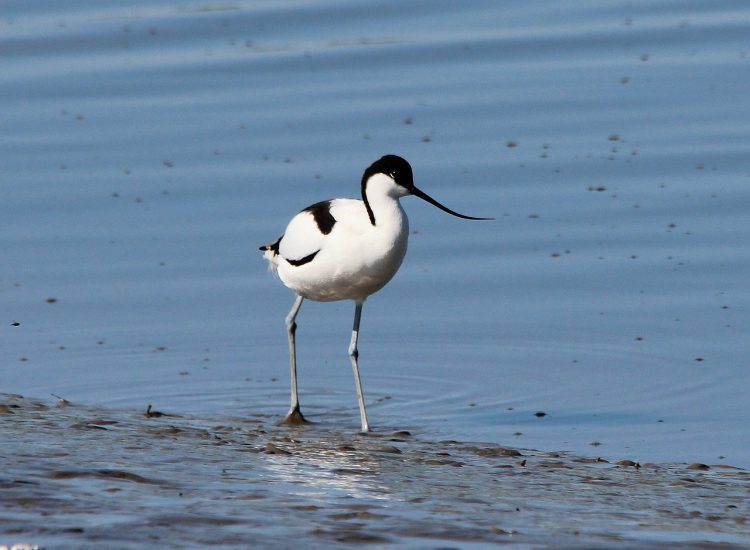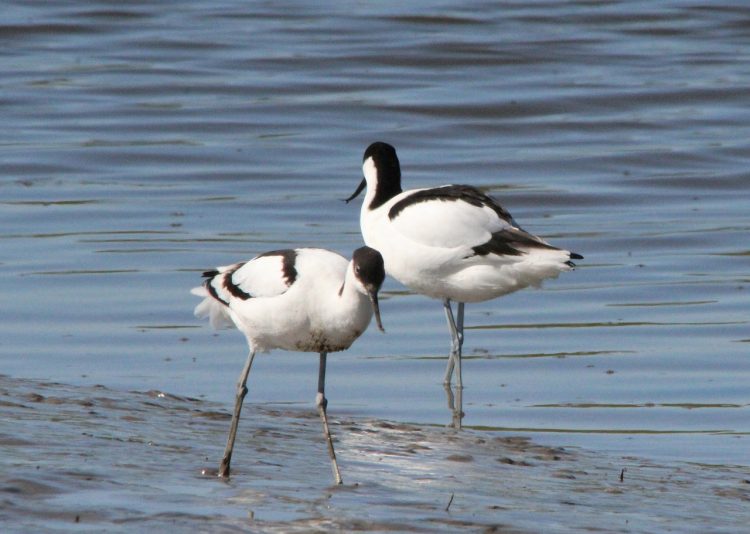Although the Avocet is still a rare British bird there is certainly never any problem of identification or recognition. The snow-white plumage is strikingly marked on the outer third of the wings. And there are convergent black bands on the back and across the wing coverts, and the nape and top of the head are also black. The most unmistakable recognition feature is the up-curved bill. The avocet is a wading bird and frequents sea-shores where it feeds on invertebrates.
Pairing and Nesting
Male and female pair in spring and the bond between them appears to be strengthened through mating. Although courtship is limited, the avocet’s mating ceremony is distinctive and attractive. The female adopts an inelegant position of readiness in thigh-deep water.

This stimulates the excited male to execute a particular dance in which he runs around the rear of the female several times from one side to another before mounting. After mating, he jumps to 7 one side of the female and both run forward together for many yards. Often one of his wings extends over the back of his mate touching gesture in human terms.
The avocet’s call is an unvarying ‘kloot’ or “kluit’-the latter being the Dutch word for avocet. The avocet is a gregarious bird that lives in colonies during the breeding season. This is probably a result of specialized breeding and feeding requirements and a consequently limited choice of sites.
The parents scrape out a nest hollow on the sandy ground close to the water. They sometimes collect and arrange dead grass or other vegetation around the nest scrape, but they do not build a nest as such. Both parents share in the incubation, which begins once the final egg is laid and lasts for 22-24 days.
The chicks start to feed themselves almost immediately after they hatch, pecking for insects and shrimps on the surface of the mud. The parents use their brood patches in feather-free areas that give direct contact from the adult’s skin to the eggs and so transfer heat. The chicks are a sandy brownish color on top, which provides some camouflage.
The avocet turns its eggs to ensure they get an equal amount of warmth. The eggs are pale brown with black blotches, and four is an average clutch. The avocet’s long legs have a strong blue tint which is particularly evident in the bird’s legs account for about half the bird’s total height.

Feeding Habits
Avocet’s feeding technique is unique among waders. It frequents saline and brackish pools and its food comprises the narrow range of creatures that can tolerate varying levels of salinity and desiccation-these include several species of shrimp, water beetles, midge larvae, aquatic flies, and rag worms. The bird feeds by sweeping the upturned bill from side to side as it moves through the water.
The availability of food differs as lagoon water evaporates in summer and salinity increases. This is a critical factor in the survival of avocet young. The size of a family feeding territory is determined by the abundance or scarcity of food. The adults take their brood to areas rich in food and defend them aggressively from neighboring families in a manner that contrasts with their mutual tolerance in nests positioned close together before the eggs hatch.
Moreover, avocets protect their chicks vigorously. The chicks, which already show some familiar markings of the adult bird, have partly webbed feet at birth. Initially, the chick’s bill is straight, but it develops the sideways feeding motion of the adult before the beak gets its characteristic upturned shape.

Also, in cloudy water, where the avocet cannot see prey clearly; it traps its food by feeling. The bird holds its bill slightly open underwater, sweeping from side to side to catch small invertebrates. In clear water or from the surface, it pecks at its prey.
Numbers and distribution
The avocet numbers in the British Isles are on the increase today-an an astounding fact considering that before World War II they had not bred in Britain for over 50 years. Although the full extent of the avocet’s former breeding distribution and numbers in Britain is not known.
It was probably never great, and almost certainly restricted to coastal areas in the southeastern part of Britain between the Humber estuary and the Sussex coast. What is known for certain is that the avocet’s decline occurred well before the end of the nineteenth century?

The drainage of fens and coastal marshes was a root cause of the decline; later, egg collecting and shooting for mounted specimens completed it. In 1947 when access was again permitted to many of the East Coast areas which had been fenced off during the war it was discovered that avocets were breeding in two sites in Suffolk Minsmere Marshes and Havergate Island, near Orfordness. Both these sites had been flooded during the war, and now provided perfect conditions of shallow water in low banks for the birds to return and breed for this Rare British Bird.
During the hot summer of 1947 wound-the-clock vigils were organized under great secrecy at both sites by pioneers of the RSPB. Four pairs of avocets bred at Minsmere that year and the same number at Havergate. Within two years of the discovery of breeding avocets the RSPB then a body of only about 5000 members negotiated a lease on Minsmere and strained its slender resources to the limit to buy Havergate Island outright.
As a result of this act of boldness and foresight on the part of the RSPB, the avocet population built up steadily through the 1950s and 1960s. During this period the number of pairs increased at both sites to a maximum of about 100 on Havergate and 50 at Minsmere.
The avocets are now dependent, like so many other breeding species, on the man-made lagoons that have been developed and are managed for the purpose. The problems have been immense at both sites, both for the avocets and for the RSPB.
They have had to combat the 1953 east coast moods, salinity variations leading to poor Pod supplies, as well as egg collectors and predation by gulls. These reverses have been successfully overcome, and the avocet is now firmly established.
The RSPB has taken the avocet as their own special emblem-an emblem that reflects the parallel successes of both the society and the birds. The need for protection is very important for avocet is an outstanding example in the British Isles of a bird that needs the security of tightly warden reserves. Therefore, as well as the skillful management that permits them to share a crowded lagoon with other species.

It is unlikely that the avocet would maintain its toehold here, were it not for the reserves at Minsmere and Havergate. Whether the avocet can spread much further in the British Isles is doubtful as suitable habitats are so restricted.
Nevertheless, as the avocet is a partial migrant we may expect visiting birds-usually from Denmark and Holland-on many estuaries in the South of England. The breeding range of the avocet extends far beyond the coastline to the shores of Africa.
Therefore, those at Minsmere disperse only to Iberia or other parts of the British Isles. This shows the enormous thermal range of the world population – from the roasting hot lakes of East Africa to the chilly, uninviting mudflats of East Anglia. So, The avocets have still considered Rare British Bird distinguished from other waders by its particularly webbed feet.

Also Read: Two-Tailed Ancient Bird Discovered
The Mystery Bird “Yellow-Billed Oxpecker
Product You May Interest






